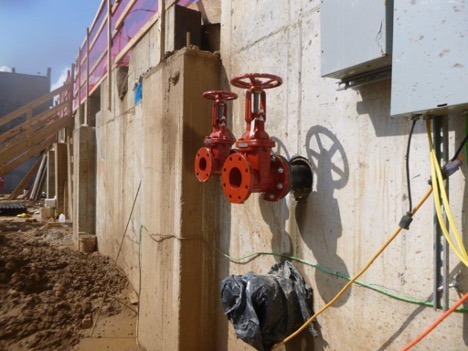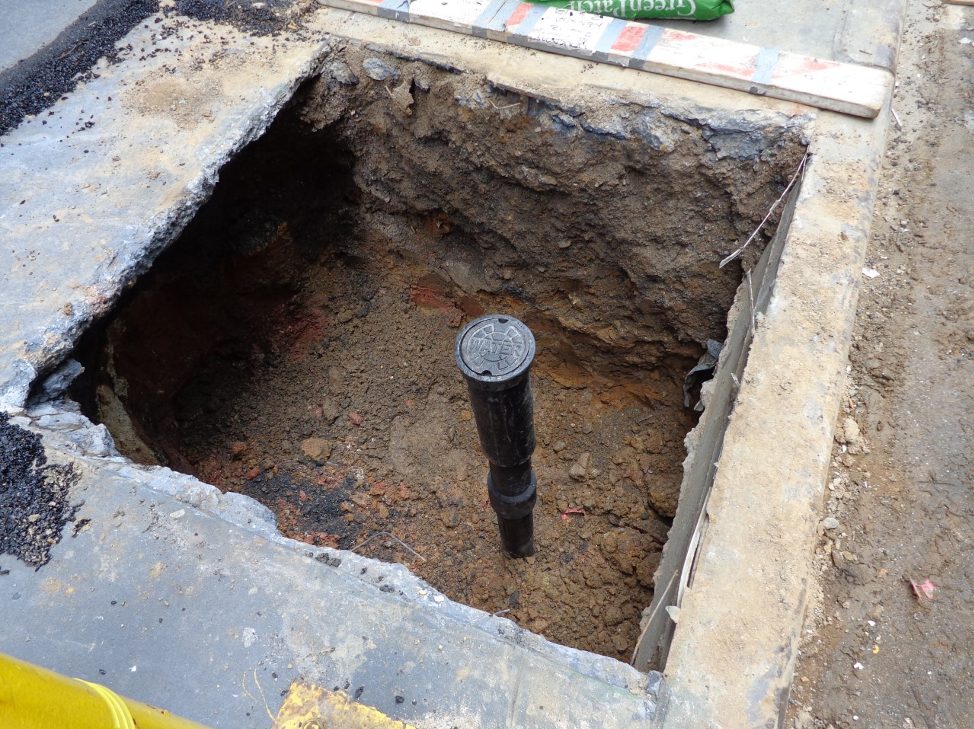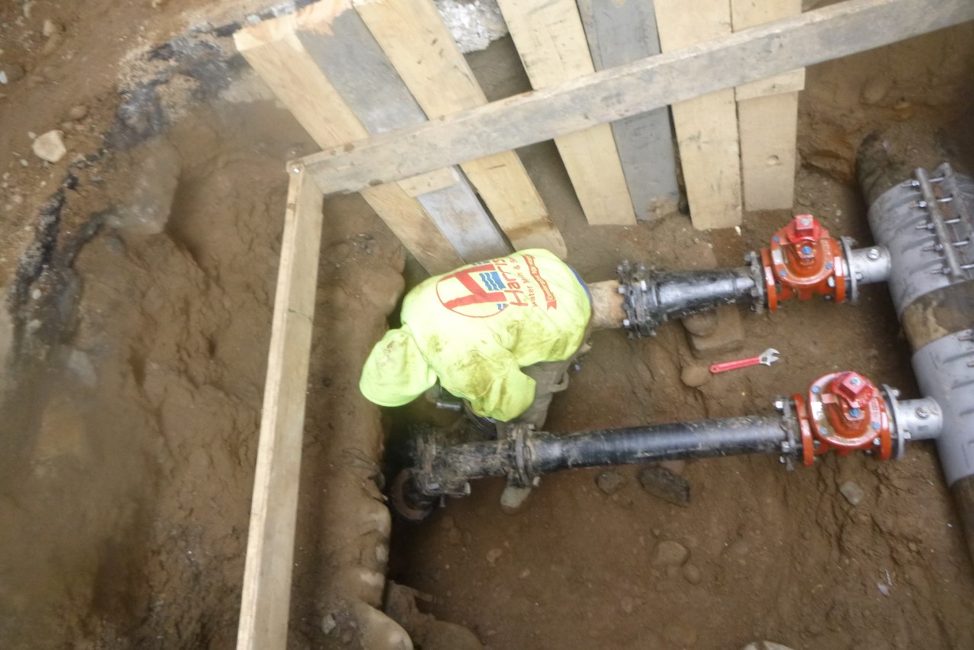Fire sprinkler pipes distribute water used for protection throughout the fire sprinkler system. This piping is what connects to each of the valves, backflow devices, and sprinkler heads. Pending on which state you live in, different materials are allowed and required to be used for your installation. For example, a fire sprinkler installation NYC may require different material from an installation in Chicago. It is best to consult with your licensed plumber on these details.
Fire Sprinkler System Components:
Alarm Check Valves
Alarm check valve is a device used to notify the house or building of a possible emergency. The alarm in the form of an electrical bell or a motor gong will sound when water flows through the alarm valve. The valves clapper will lift off of the seat of the valve and water will flow through the alarm valve.
Back Flow Prevention Devices
A back flow prevention device is used to protect potable water from contamination due to backflow from the sprinkler system. The device is installed onto the sprinkler or combined water main pipe and allows for water to flow in one direction only. The valve has a flap on the inside that opens in one direction allowing water to flow in the system from the city main under the roadway. The gate (flap) will remain in the neutral position if the water attempts to flow backwards towards the city main in the roadway.
Butterfly Valves
A butterfly valve is a common valve which is used to control the water flow in a system. You can determine if the valve is open or closed by reviewing the handle on the valve. The purpose of the valve is to prevent water hammer of reduce hydraulic shock within the system.
OS&Y Valves
The OS&Y Valve (AKA Control valve) controls the flow or water through the sprinkler system. If the valve is in the closed position it is not possible for water to flow into the sprinkler system from the street. All of the water will remain in the pipe from the OS&Y valve to the city main in the roadway.
The OS&Y component of the fire sprinkler system stands for outside screw and yolk. It functions with the opening and closing of the gate, which lowers in and out of the valve. The goal is for it to become apparent when the valve is open or closed as part of maintaining the building for fire protection. If the stem is raised it means that the valve is open and functioning. If you cannot see the stem sticking out of the top of the valve, it means that the valve is closed—which is important for easy identification.
Sprinkler Heads
A sprinkler head is the component of an automatic fire sprinkler system that releases water when the sprinkler system has detected a possible fire. The most common type of sprinkler head is the pendent sprinkler head which is primarily used in offices, hotels and factories. This type of sprinkler head hangs down from the ceiling and sprays water in a circular motion to cover as much space as possible. The deflector is a part of the sprinkler head which is used to direct the water once it flows from the sprinkler head.
Another common type of head is the upright head, which is pointed towards the ceiling and in this case the deflectors are curved in the downward position so the water sprays in a dome like position.
The concealed sprinkler head is like the pendent head with the only difference being that it has a concealed head to assist it with matching the ceiling. The cover plates will remove once the sensors are alarmed of a specific degree of heat.
The final most common sprinkler head is the sidewall sprinkler head which are most commonly used in a confined space like small rooms or hallways. They are most commonly installed in a wall or hidden under a piece of the ceiling structure.
Curb Valves
A curb valve is also known as a curb stop box which is used to control the water from the city main to inside the building. A fire sprinkler installation in NYC requires the curb valve to be installed within 2’ of the city curb line as part of the current plumbing code unless there is an obstruction in the form of a tree, bus station, statue etc. The old plumbing code required the curb valve to be within 2’ of the foundation wall which is no longer acceptable in NYC.
The curb valve is most commonly used by the fire department if they have to close the water for the building or if the building requires any form of a repair on the inside and the main control valve is not functioning.
Wet Connection Valve
The wet connection valve or wet tap is the valve that is installed on the city main and regulates the water from the city main into fires sprinkler system. The wet connection valve is installed by the city agency who regulates the water supply in most cases, but the licensed plumber is responsible for all permitting, excavating, cost, and inspections that are associated with the wet connection installation.
Siamese Connection
A siamese connection is used to allow for the fire department to pump water into the standpipe or fire sprinkler system as supplementation form for the buildings water supply. The connection is usually located on the outside of the building giving easy access to the fire department as needed.
Fire Pump
A fire pump is used to provide additional pressure for the water supply if required to meet the specifications of the hydraulic design.
NYC Fire Sprinkler Installation Explained
A new fire sprinkler installation always requires approved plans by both the NYC DEP and the NYC DOB. Both sets of plans have to be submitted to DEP for review before the formal permits are released. Once your licensed plumber has the approved permits in hand, the company can then submit for your DOT permit. The DOT permit will allow for opening of the roadway, which is always required prior to the scheduling date for the new wet connection.
Once the DOT permit is in hand, the plumber can submit for a wet connection installation date which is determined by the DEP. The plumber must schedule the job around DEP availability to install the new wet connection.
Often, the fire sprinkler main is installed in two days. This will include the plumber to spend one day on site excavating and the second day on site to install the piping. The piping installation includes the curb valve to be installed within 2’ of the curb, OS&Y valve on the inside of the foundation wall, and all of the pipe in-between.
Once the pipe system has been installed and inspected, the licensed plumber will backfill all of the excavations and prepare the sidewalk/roadway for final restoration of the concrete and asphalt. The licensed plumber usually has an in-house crew who specialize in both concrete and asphalt restoration which are both to be completed under specific DOT requirements. In the event that the roadway or sidewalk is not completed up to DOT standards the licensed plumber is responsible for resolving any open issues for a period of 3 years after the permit has expired. This is the same for the piping installation, all contracts should include a guarantee period where the plumber is responsible for any leaks that may occur on the required time frame per contract.
The internal plumber can now take over and install the meters, backflow prevention device, and any internal sprinkler piping left for completion.
Ultimately the building is seeking a completion for the piping installation including DEP inspections, DOB inspections, and final signoffs for the job.
It is important to contact a licensed master plumber if you have any questions regarding the replacement of your existing sprinkler or the installation of your new fire sprinkler system.























